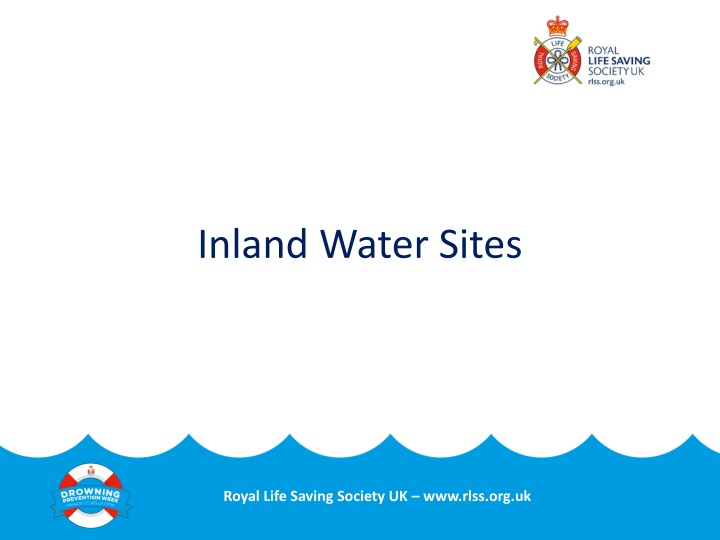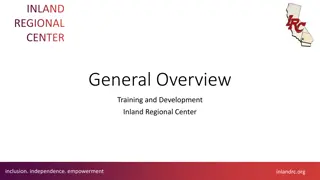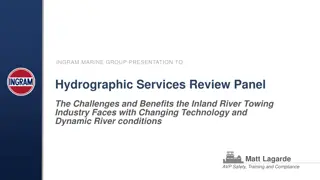Staying Safe Around Inland Water Sites - Tips and Dangers
Over half of drownings occur at inland water sites like rivers, lakes, quarries, reservoirs, and canals. It's important to understand the risks associated with open water swimming and the precautions to take. Cold water can be particularly dangerous, affecting swimming abilities and posing immersion risks. Tragic incidents, like the drowning of a teenage boy in a quarry, emphasize the importance of water safety awareness. Stay vigilant near water, follow safety guidelines, and always prioritize caution.
Download Presentation

Please find below an Image/Link to download the presentation.
The content on the website is provided AS IS for your information and personal use only. It may not be sold, licensed, or shared on other websites without obtaining consent from the author.If you encounter any issues during the download, it is possible that the publisher has removed the file from their server.
You are allowed to download the files provided on this website for personal or commercial use, subject to the condition that they are used lawfully. All files are the property of their respective owners.
The content on the website is provided AS IS for your information and personal use only. It may not be sold, licensed, or shared on other websites without obtaining consent from the author.
E N D
Presentation Transcript
Inland Water Sites Royal Life Saving Society UK www.rlss.org.uk
Inland Water Sites Over half of drownings occur at inland water sites which include rivers, lakes, quarries, reservoirs and canals. That s over 200 drownings every year! Many of these drowning occur because people assume that swimming or jumping into open water is similar to using a swimming pool. Open water can be used safely, but there are a lot more things to consider when going into open water compared to a swimming pool Whenever you are near water: Stop and Think Stay Together In an emergency: Call 999 or 112 Float Royal Life Saving Society UK www.rlss.org.uk
Cold Water Even during the summer the open water sites stay very cold, particularly the deeper water just a few metres from the shore. If you want to swim, try to enter from somewhere shallow, and swim parallel with the shore so you can stand up if you start to feel tired or if you inhale water. If you re going into deeper water, or jumping in, it s a good idea to go with an organised group with rescue cover, get used to the temperature first, and wear a wetsuit.
Cold Water After the gasping and hyperventilation response to getting into cold water has passed (0-3mins), how much can cold water reduce your ability to swim? A research study took 10 good swimmers and asked them to swim in water of 25 C, 18 C, and 10 C for 90mins. How many do you think completed the swims: Water Number of swimmers who completed the swim Temperature 25 C 10 18 C 8 10 C 5 How long can you swim continuously for in a standard 30 C swimming pool? Considering the standard of the swimmers in the research, how long do you think you could swim in 10 C water? If you are not experienced swimming in cold water, it s probably just a couple of minutes Immersion deaths and deterioration in swimming performance in cold water : Michael Tipton, Clare Eglin, Mikael Gennser, Frank Golden
Who Drowns in Open Water? Teenage boy drowns in a Lancashire quarry A 13-year-old boy has drowned after swimming at Hill Top Quarry in Whittle-le-Woods, near Chorley. Emergency crews were called to the site but the boy was pronounced dead at the scene, according to a police spokesman. The boy s mother paid tribute to her son who she described as a "bright young man who enjoyed life to the maximum and was a thrill seeker. He was funny, special and a talented athlete, was loved by all his family and friends and was a brilliant big brother to his brothers and sister and a fantastic son. He was a very capable swimmer . She said the family had been left "totally devastated". "It has left a massive hole in our lives and our family is incomplete without him, though he will never be forgotten. Life will never be the same. I want people to know that he was a strong lad and a very capable swimmer, despite this he still found himself in trouble and unable to swim a short distance to safety. This message is to highlight the dangers of open water and the devastation it can bring to any normal family." A Councillor of Chorley Council, said the local areas of open water had always been popular with young people. "We are surrounded by water and the water is a big attraction to kids when it is nice weather," he said. "This is used quite a lot and has been for many years. Source: http://www.bbc.co.uk/news/uk-england-lancashire-14010665
Identify the Hazards at Open Water Sites CANAL LAKE QUARRY RESERVOIR RIVER CANAL LAKE QUARRY RESERVOIR RIVER END ACTIVITY END ACTIVITY Produced for RLSS UK by Forward Back Forward Back Royal Life Saving Society UK www.rlss.org.uk Exit Exit
Canal Hazards: 4 to find! Resetting Hazards Menu Exit RevealAll Reset Exit Menu
Canal Hazards: 4 to find! Currents Canal Traffic Risk: Danger of being swept away from the edge and into deep, cold water. Currents Precautions: Only enter rivers as part or an organised swimming or activity event with safety cover. Bridge Canal Traffic Bridge Bank Risk: Danger of being hit by boats if you fall in. Risk: Danger of broken legs and/or spinal injury from falling or jumping from bridge. Bank Precautions: If you do fall in, swim directly towards the bank and climb out. If you can t climb out shout and Risk: Bank may be slippery and may collapse due to erosion. signal for help, and to make boat aware of your presence. Precautions: Don t lean over the side of the railings, and don t jump from bridges. Precautions: Keep yourself, children, and pets away from the edge. RevealAll Menu Exit Reset Exit Menu Reset
Lake Hazards: 4 to find! Resetting Hazards Menu Exit RevealAll Reset Exit Menu
Lake Hazards: 4 to find! Rocks Vegetation Rubbish/ Pollution Rubbish/Pollution Rocks Risk: Broken bottles and cans can cause cuts. Pollutions such as sewage, and run-off from farms and fields can cause serious health problems. Vegetation Hidden Features Risk: Rocks pose a slip, trip, fall and entrapment. Cuts from rock can become seriously infected if the water is polluted. Risk: Blue-Green Algae produces toxins which can Hidden Features cause allergic reactions and potentially serious medical conditions. Vegetation can make rocks slippery and can hide sharp debris in the water (glass bottles are common). Precautions: Look for rubbish and signs of pollution e.g waste water pipes. Precautions: Be careful when moving in shallow water and do not jump into water when you cannot see what is underneath. uneven ground. Risk: You cannot see what is below the water in a lake. Possible hazards include glass, sharp rocks & Precautions: Do not enter water which has Blue Green Algae. Be careful when paddling and walking over Precautions: If you cannot see below the surface, do not jump in. Check for warning signs. vegetation. Wear some footwear in the water if possible. Menu Reset Exit RevealAll Reset Exit Menu
Quarry Hazards: 6 to find! Resetting Hazards Menu Exit RevealAll Reset Exit Menu
Quarry Hazards: 6 to find! Unstable Bank Trees on Bank Risk: The bank can erode and crumble under the top soil, becoming very ustable. Rocks Deep & Cold Water Risk: The tree roots may destabilise the bank, making it more likely to collapse if you get near the edge. Risk: Most quarries contain very deep water which does not warm up in summer due to its depth. The affects of submersion in cold water can be fatal. Unstable bank Precautions: Keep yourself, children, and pets away from the edge. Precautions: Keep yourself, children, and pets away from the edge. Underwater current Precautions: Only swim in quarries that have been decommissioned and adapted for swimming, which should include the provision of safety cover. Be aware of the affect of cold water on Hidden features Hidden Features Rocks your ability to swim and control your breathing. Risk: You cannot see what is below the water in a quarry. Possible hazards include mining/industrial waste products (including chemicals and machinery), dumped rubbish, pollution, highly variable depths, and sharp rocks. Vertical Bank Shear face Risk: Rocks pose a slip, trip, fall, and entrapment hazard and may also be unstable. Risk: Vertical walls make getting out difficult, especially in an emergency. Trees on bank Precautions: Avoid climbing on rocks around quarries. Precautions: Keep yourself, children, and pets away from the edge, and do not jump into quarries. Precautions: Do not jump into quarries. Menu Reset Exit RevealAll Reset Exit Menu
Reservoir Hazards: 3 to find! Resetting Hazards Menu Exit RevealAll Reset Exit Menu
Reservoir Hazards: 3 to find! Deep & Cold Water Hidden Objects Hidden objects Risk: Most reservoirs contain very deep water which does not warm up in summer due to its depth. The affects of submersion in cold water can be fatal. Risk: As reservoirs are often formed in flooded natural valleys, they often have a very variable waterbed (depth and composition), and also often contain debris. Cold water Shear Wall Precautions: Only enter reservoirs that have been approved for swimming or watersports, which should include the provision of safety cover. Be aware of the affect of cold water on your ability to swim and control your breathing. high banks and sloped beach areas. Beach areas are easier to get in and out of the water, but be aware that if you move away from where you enter the water you may also be moving away from the only way out. Precautions: If access to the water is permitted, be cautious when entering the water , and stay within permitted areas. Walls, Banks, & Beaches Risk: Reservoirs tend to be bordered by a mixture of Precautions: If access to the water is permitted, make sure where you enter the water is safe, and that you also have an exit route planned. Remember that the emergency services cannot always reach isolated water sites. Menu Reset Exit RevealAll Reset Exit Menu
River Hazards: 8 to find! Resetting Hazards Menu Exit RevealAll Reset Exit Menu
River Hazards: 8 to find! Currents Hidden objects Risk: Danger of being knocked off your feet and swept away. Rocks Cold water Risk: Rocks pose a slip, trip, fall, and entrapment hazard and may be hidden beneath vegetation. Precautions: Look for visible currents in the water and warning signs along the bank. Hidden Objects Currents Waterfall Rocks Precautions: Be careful when moving on the bank and in shallow water. Do not jump into water when you cannot see what is underneath. Trees on Bank Precautions: Risk: In isolated areas, and areas exposed to the Risk: Cannot see what is under the water: it may shallow or be filled with rocks or rubbish. Risk: Fast moving water with strong currents moving over rocks with a drop in height. Safety Railings and Barriers White water Cold water Mist - White Water Ahead If there is a safe place to enter the water, do so slowly and look closely for hazards as you enter. Approach with caution, if trying to cross the river do so further upstream or downstream in a place where the current is weaker. weather conditions railings often become damaged and weakened. Precautions: Risk: River water can be very cold, even in the summer. The affects of submersion in cold water can be fatal. Fast moving water with strong currents moving over rocks. Waterfall Risk: The tree roots may destabilise the bank, making the bank more hazardous. Risk: Railings Trees on bank Precautions: Do not get into water without testing its temperature first, whilst also looking out for potential hazards. are rafting, kayaking, or gorge walking, approach with caution following the guidance of the activity leader. Precautions: Approach the bank carefully, checking the ground conditions. Precautions: Don t expect railings and barriers to be able to support your weight. Precautions: Avoid this area if you are swimming or walking. If you Menu Reset Exit RevealAll Reset Exit Menu
Other sessions to look at Introduction to Drowning and Cold Water Coastal and Beach Water Sites Inland Water Sites Orienteering Hazard Hunt Witness Statement Royal Life Saving Society UK www.rlss.org.uk























